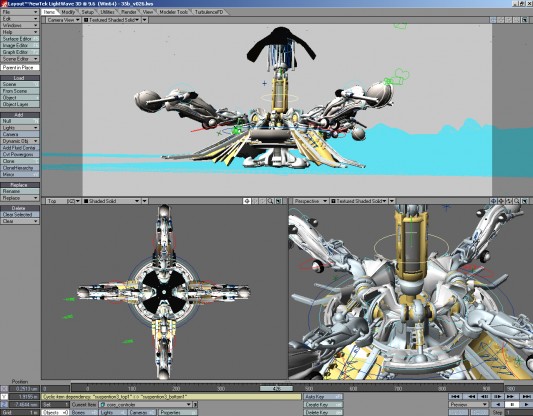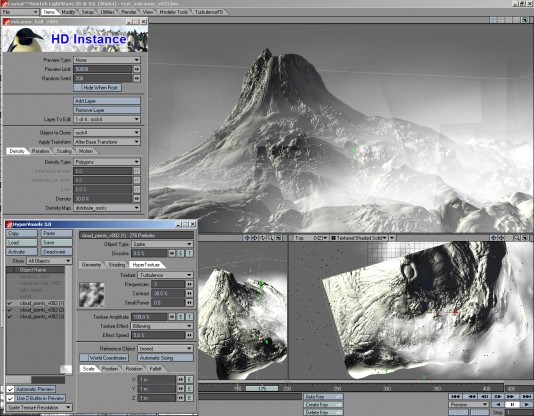Artist Richard Mans embraces LightWave as he embarks on his filmmaking career.
“Abiogenesis was a labor of love. A doodle taken to the nth degree,” says artist Richard Mans, describing his first animated short film.
After spending several years as a freelance animator, Mans wanted more. He wanted to create art with meaning. He wanted to take his work to a new level. He wanted more from his existing software tool set. “I realized
that the only way forward for me,” he says, “was to make a short film.” And Abiogenesis was born.

“I started working on the robot that is the main character in the film when I first started teaching myself animation—just playing around with shapes in 3D space, with no grand designs,” Mans describes. The digital robot became part of his first show reel, was developed a bit further as a show piece, and then simply made for an interesting spectacle.
After resolving to make a short film, Mans had trouble settling on an idea for the piece. “I wanted to create something that would advance my work and style, be unique to my sensibilities, and inspire a sense of awe and beauty, while touching on universal themes.” The idea for what would become Abiogenesis fell into place when Mans saw animations depicting NASA’s Mars Rover, inspiring him to ascribe a meaningful mission to his own robot.
Tactical toolkit
For his moviemaking mission, Mans opted to abandon a complex 3D software application that would require pricey upgrade cycles in favor of a capable, full-featured solution that was affordable, streamlined, and easy to use. “I wanted to see if there was an application out there that was a little easier to use,” he recalls. “Also, I was going to be making a film and not earning any money for the next few years, so I started looking for an application better suited for the solo artist trying to make a film.” After comparing alternatives, he chose NewTek’s LightWave 3D animation, modeling, and rendering software. “I was searching for alternatives, and saw that LightWave could do all the things I needed to make my film, at a more affordable price.”
At first blush, Mans was attracted to LightWave for its powerful animation and rendering capabilities, but he found much more under the hood. “It had all the basics I needed to animate with: a Bones system, Inverse Kinematics, a Dope Sheet, and a Graph Editor,” he explains. “I planned to use something else for modeling, but I quickly discovered that LightWave was good for that, too. Other key elements drew me to LightWave: It had particles, dynamics, HyperVoxels, and unlimited render nodes—all at a very low price compared to other packages.”

Mans employed LightWave throughout the entire process of making Abiogenesis, from animatics to final renders. Using the software to model, animate, and render the film, Mans said he was impressed with LightWave’s performance and found it to be more stable than other tools. His confidence and comfort with LightWave also grew the more he used the software. “I could quickly find any options I was looking for, and I started to enjoy the interface with the text-style buttons, which I found easier to use than picture icons.”
What helped Mans the most in making Abiogenesis was LightWave’s workflow. “At first, I found the split between Modeler and Layout a bit strange, but the further I got into making my film, the more I came to appreciate the clear cut nature of this workflow,” he says. “Having the two separate interfaces for Modeler and Layout was like having two specialist applications best suited for the task at hand.”
LightWave’s Layouts capabilities brought more order to the workflow, eliminating any confusion as to whether Mans had done extra modeling in a scene or referenced a model, for example. “It made updating models or switching them out with different resolution versions quick and reliable,” he explains. “It kept the scene file sizes very small, enabling me to save as many iterations of a scene as I wanted without thinking twice about it.” This feature proved particularly important when working with more than 80 shots and numerous incremental saves.
Mans further streamlined his creative workflow by combining LightWave use with a gamepad controller. “I hardly ever use LightWave without my gamepad,” he affirms. “It has seriously sped up my workflow, as well as eliminated any problems I was having with repetitive strain injury (RSI),” a painful muscle condition. He recommends that fellow LightWave users try using a gamepad, with a layout similar to that of a Sony PlayStation 3 controller,
programmed for all the LightWave hotkeys.
Enlightening experience
“It was a great experience, after years of feeling like I was in over my head when working in 3D animation, to suddenly being in control,” Mans adds. “The way LightWave works just maps out better in my head. In this respect, I feel LightWave is responsible for getting my film across the finish line. No matter what shot I was working on, I felt in control and confident that LightWave could handle it.”

In the making of Abiogenesis, Mans unearthed a real desire to continue making films. “Even though Abiogenesis was easily the hardest thing I’ve ever worked on, I now see it as only the start of a very long journey into the world of filmmaking,” continues Mans. “Based on my very positive experience with LightWave while making Abiogenesis, LightWave will most likely feature prominently in the making of my next film.”
Mans is already proactively setting new goals. The artist’s next steps are to feature Abiogenesis in a few film festivals, perhaps to gain a small profile as a filmmaker, and to meet like-minded people who may be able to help with his next film.
Looking back, Mans achieved all he wanted and more. And he is happy to impart what he learned from going through this process to fellow and budding filmmakers. “Making an animated short film on your own can be incredibly challenging at times,” he admits, “but there is light at the end of the tunnel, so long as you chip away at it almost every day and keep believing in yourself and your idea.”






